CHAPTER I ERYTHROXYLON COCA, ITS BOTANICAL CHARACTER
| Books - Coca and Its Therapeutic Application |
Drug Abuse
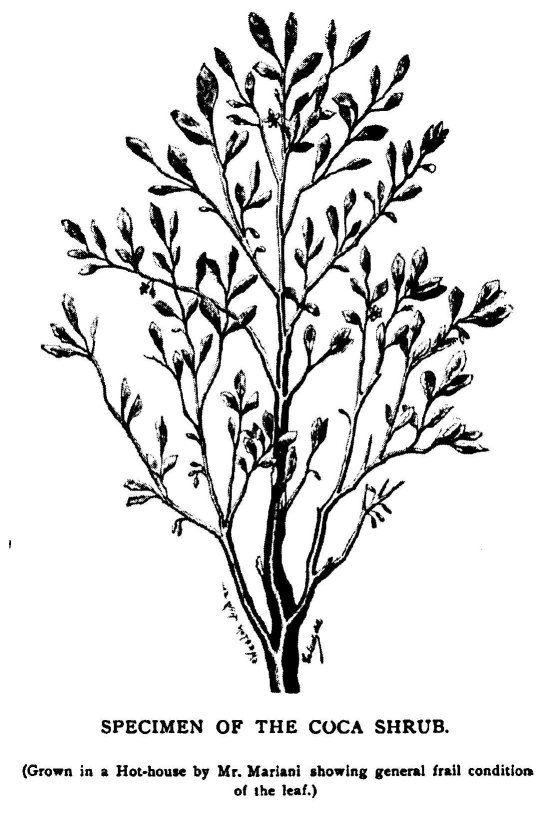
CHAPTER I.
ERYTHROXYLON COCA,
ITS BOTANICAL CHARACTER.
COCA is indigenous to South America. The different botanists disagree as to which exact family it should be assigned. Linnaeus, De Candolle, Payer, Raymundi of Lima, Huntk, and others, place it in the family of the Erythroxyleae, of which there exists but one genus, the Erythroxylon, while Jussien adopts another classification and places it in the family of the Malpighiaceae (genus Sethia). Lamarck, on the contrary, believes that this plant should be classed among the family of Nerprem (Rhamneae).
Erythroxylon Coca is a shrub which reaches a height of from six to nine feet and the stem is of about the thickness of a finger. In our climate it cannot thrive except in a hot-house, and there its height does not exceed one metre.
The root, rather thick, shows multiple and uniform divisions; its trunk is covered with a ridged bark, rugged, nearly always glabrous, and of a whitish color. Its boughs and branches, rather numerous, are alternant, sometimes covered with thorns when the plant is cultivated in a soil which is not well adapted to it.
The leaves, which fall spontaneously at the end of each season, are alternate, petiolate, with double intra-accillary stipules at the base. In shape they are elliptical-lanceolate, their size varying according to the nature of the plant or of the soil in which it grows.
The leaf of Coca gathered in Peru, of which we give two figures of the natural size, is generally larger and thicker than the leaf of the Bolivian Coca. It is also richer in the alkaloid, consequently more bitter
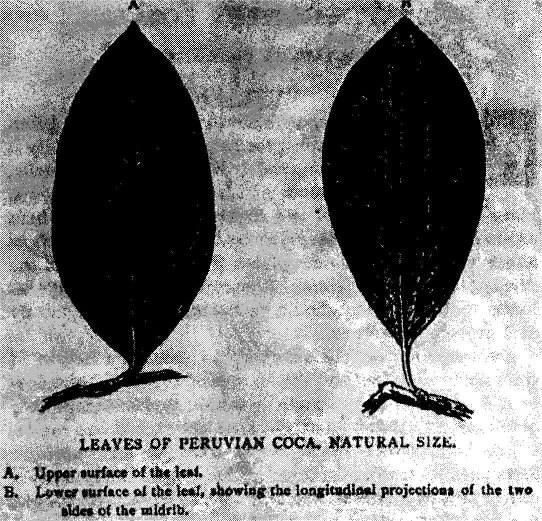
The Coca leaf from Bolivia, smaller than the Peruvian leaf, is as much esteemed as the latter. although it contains less of the alkaloid. It possesses so exquisite and so soft an aroma, indeed, that the coqueros seek it in preference to any other.
The Coca leaves of Brazil and Colombia are much smaller than those of Peru and Bolivia. Their color is much paler. Containing but traces of the alkaloid they are not bitter, and possess a pleasant, but very volatile aroma.
One of the most important characteristics of the Coca leaf is the disposition of its nervures ; parallel with the midrib two longitudinal projections are to be seen, which, starting from the base of the leaf, extend in a gentle curve to its point.
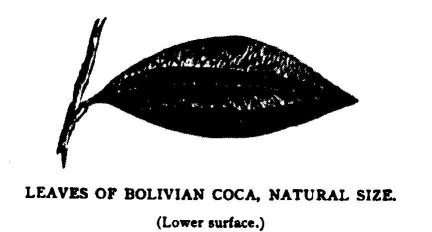
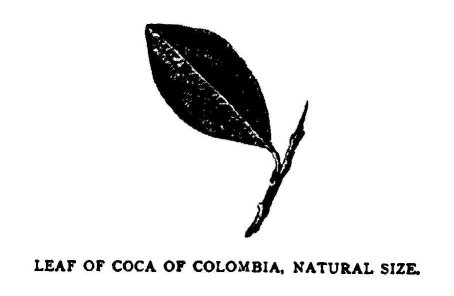
The upper surface of these leaves is of a beautiful green tint ; the lower surface of a paler green, except, however, near the midrib. At this point, there is a strip of green darker than the rest, which becomes brown in the withered leaves.
The flowers, small, regular and hermaphrodite, white or greenish yellow, are found either alone or in groups in little bunches of cyme at the axil of the leaves or bracts, which take their place on certain branches. The disposition into cymes is that most commenly met with. They are supported by a slender pedicel, somewhat inflated at the top, the length of which does not exceed one centimetre.The sepals, jopined at the base and lanceolated, are of a green tint with a whitish top. The Petals, half a centimetre in length, pointed, concave inside and yellowish white, exhale a rather pleasant odor. They are provided with an exterior appendage, of the same color and of the same consistency, surmounted on each side with an ascending fimbriated leaf, irregularly triangular in shape. The stamens at first joined in a tube for one-third of their length, afterwards separate into white subulated strings, provided with an obtuse avoid anther which extends a little beyond the petals. The ovary is ovoid in shape and green in color, thickening at the top into a yellowish glandular tissue. The style which rises above it separates into three diverging branches, provided with orbicular papilliform bodies at their extremity, obliquely inserted into the slender patina.
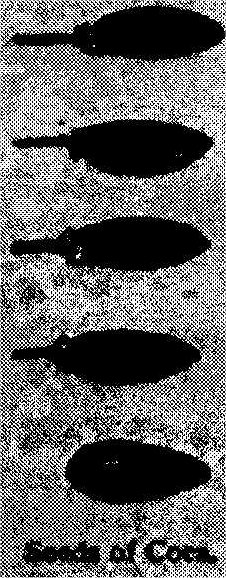
The fruit is a drupe of an elongated ovoid form, being a little more than a centimetre in length, of a reddish color when fresh, and having a tender, thickish pulp inclosing a seed. This seed shows longitudinal furrows and alternate vertical projections which make its division irregularly hexagonal. When the fruit is dried, the skin assumes a brownish color, shrivels up and molds itself on the protuberances and irregularities of the seed.
CULTIVATION OF COCA.
Erythroxylon Coca appears to have come originally from Peru, and from there its cultivation was carried into Bolivia, Ecuador, New Grenada, and Brazil, in a word, throughout the entire torrid zone of South America.
For some time, as a result of the extended consumption of Coca and for a still stronger reason, now that the day is at hand when the consumption of Coca will assume greater proportions, numerous plantations of Coca trees have been laid out in regions where that shrub was formerly unknown. We take pleasure in recording that these attempts have proved successful in the Antilles, thanks to the disinterested sacrifices of our friend, Dr. Betances. It is also with pleasure that we present anew an interesting communication made by the learned doctor to the "Societe d'Acclimatation de France" as appeared in the Revue Diplomatique, 17th of March, 1888.
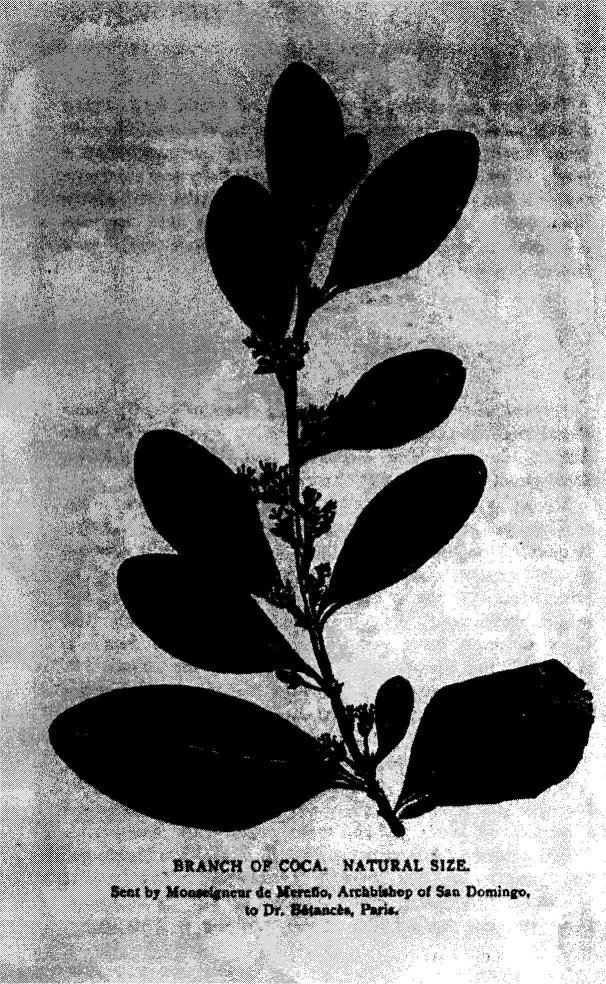
"Dr. Betances has succeeded in acclimatizing Coca in the Antilles. At considerable expense and after numerous shipments of seeds and the transportation of plants (this with the greatest difficulty) to Porto Rico and San Domingo, Dr. Betances had the pleasure of receiving a fine branch of Coca in full bloom, which was sent to him by Monseigneur Merefto, Archbishop of San Domingo. This twig, which the members of the Society were enabled to examine, excited the most lively curiosity and won the commendation of M. Geoffroy Saint-Hilaire. It was raised from a plant which had been only eighteen months under cultivation."
"In Porto Rico the plant reaches a greater height than in Peru.
"A box filled with beautiful leaves has also been received by Dr. B•Stances and forwarded to Mr. Mariani. This also came from Monseigneur Mereno.
"It is therefore evident that the plant can be cultivated in the Antilles ard that it may become a source of wealth to that country."
Plantations like this would probably thrive in Corsica or Algeria, countries where the temperature at certain points is somewhat analogous to that of the tropics.
It is a fact that this shrub does not attain its complete development except in countries where the mean temperature is from fifteen to eighteen degrees centigrade.
But heat does not suffice; great humidity is also necessary to Coca Therefore it is met with principally on the sides of hills and at the bottom of wooded valleys which abound on both sides of the Cordillieras. Unfortunately, these regions are rather distant from the coast and they are, furthermore, devoid of easy means of communication; it is above all to this particular cause, the difficulty of transportation, that we must attribute the relatively high price of Coca leaves.
The cultivation of Coca trees is begun by sowing the seed in beds called A/mass:cos. As soon as the plant appears it is protected from the heat of the sun by means of screens and matting ; when it reaches a height of from 40 to 60 centimetres, it is transferred to furrows 18 centimetres in length by '7 in depth, care being taken that each plant is separated from its neighbor by a distance of a foot.
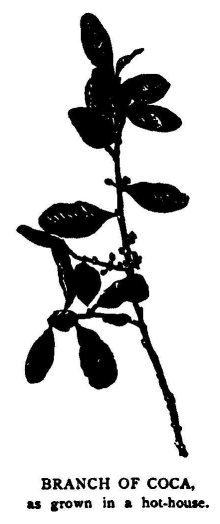
(1) This cut represents the Coca shrub presented by Mr. A. Mariani to the Paris Botanical Gardens.
During the first year maize is sown in the interspaces, rapidly overreaching the shrub, and taking the place of the screens and mats.
The growth of the Shrub is rather rapid, reaching its full height in about five years. But the time when it becomes productive precedes that at which it attains its complete height by about 8+ years after being planted.
After that, when the season has been especially damp, it yields as often as four times a year.
Attempts have been made to acclimatize it in Europe, but so far without success. As early as 1869 the cultivation of it was tried in the Botanical Garden of Hyeres, but no satisfactory result was obtained. We presented, in 1872, two samples to the appreciative and learned director of the Garden of Acclimatization of Paris, M. Geoffroy Saint-Hilaire, and notwithstanding all the care taken of the young plants, they failed to reach their full growth. Several frail Coca plants may be seen in the conservatories of the Jardin des Plantes de Paris, in the Botanical Gardens of London, of Brussels, etc., likewise at several great horticulturists of Gand, notably Van Houten's. As may be seen by the large colored engraving (1) and by the branch engraved above, these specimens of Erythroxylon Coca are very far from giving an idea of the plant growing in the open air, in a soil and under a temperature that are favorable to its development, as shown by the leaves of Peruvian Coca, illustrated above, and which come from one of the newest haciendas of Santa-Anna, belonging to M. M.-P. Concha, bordering on the territory of a savage tribe of Antis or Campas, on the Urubanba river, which joins the Amazon in latitude 12° S., longitude 75° W.
GATHERING OF COCA.
The plant begins to yield when it is about a year and a half old.
The leaf is the only part of the plant used.
It should be gathered in dry weather; this is entrusted generally to women, and simply consists in plucking each leaf with the fingers.
The leaves are received into aprons, carefully carried under sheds, to shelter them from the rain and dampness, dried, and then packed.
We quote from the Voyage dans la region du Titicaca, by Paul Marcoy, the following passage (" Tour of the World," May, 1877): "Of all the valleys of the Carabaya group, Ituata is the one where Coca is cultivated on the largest scale. They were then at the height of the work, peons and peonnes were following each other through the plantations of the shrub, so dear to the natives that a decree of 1825 placed it in the crown of the arms of Peru, alongside of the vicunia and cornucopia, or horn -of-plenty. Men and women carried a cloth slung across the shoulders in which were placed the leaves, as they gathered them one by one. These leaves, spread out on large awnings, were exposed to the sun for two or three days, then packed up in bags of about one metre in size, and sent off to all parts of the territory.
"This gathering of the Coca is just such an occasion for rejoicing for the natives of the valleys, as reaping-time and harvests are for our peasants. On the day when the gathering of the leaves is finished both sexes that have taken part in the work assemble and celebrate, in dances and libations, the pleasure they experience in having finished their labors."
In 1851, the annual production of Bolivia was estimated to be more than 400,000 certos (800,000 kilogrammes) of Coca leaves, of which three-quarters came from the province of Yungas.
| < Prev | Next > |
|---|












